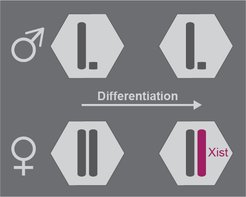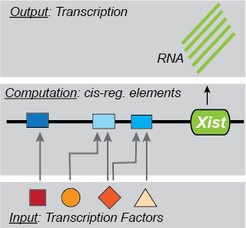Research
Our projects
1. Female-specific and mono-allelic Xist upregulation

The process of X-chromosome inactivation has evolved in mammals to ensure dosage compensation for X-chromosomal genes between the sexes. It is initiated in female embryos by upregulation of the Xist RNA from one randomly chosen X-chromosome, which will then undergo inactivation. One of the major aims of our group is to understand how cells establish this female-specific and mono-allelic expression pattern of Xist.
To investigate the structure and function of the gene-regulatory network that ensures mono-allelic and female-specific Xist expression, we are using an interdisciplinary approach that combines mathematical modeling with a series of quantitative experimental techniques. In this way hope to elucidate (1) how cells can reliably distinguish between a single and a double dose of X-linked genes, (2) how the two copies of the Xist gene in a female cell can assume such divergent expression states and (3) how the Xist can maintain epigenetic memory of its expression state.
Mutzel et al. 2019, Mutzel & Schulz 2020, Pacini et al. 2021
2. Signal-decoding by Xist’s cis-regulatory landscape

The Xist gene decodes multiple quantitative signals to establish the correct expression pattern. X-dosage sensing allows female-specific upregulation, while integration of developmental signals triggers the onset of X inactivation at a specific time of embryonic development. To identify transcription factors and cis-regulatory elements that mediate signal-decoding at the Xist locus, we perform pooled CRISPR screens with a dedicated assay we have developed. Through integration with epigenomic profiling, (epi-)genetic editing and additional screening assays we then dissect how different signals are integrated and interpreted across multiple regulatory layers.
Ravid Lustig et al. 2022, Gjaltema & Schwaemmle et al. 2022, Genolet et al. 2022
3. Interplay of X-inactivation and stem cell differentiation
X-inactivation is initiated through Xist upregulation, when cells exit the stem cell state. However, in turn also the process of X-inactivation modulates the differentiation process since a double dose of X-linked genes inhibits differentiation, potentially to ensure a tight coordination of X-inactivation and development. To shed light into the underlying mechanisms we have identified X-linked genes mediating the effect and we are performing a systematic comparison of the signaling and gene-regulatory networks in cells with one or two X-chromosomes using genomics and phospho-proteomics.
4. Synthetic biology approaches to dissect epigenetic regulation
To complement our efforts towards dissecting the complex cis-regulatory landscape of Xist, we have recently started to use synthetic biology approaches to test the identified regulatory principles in isolation. We are developing high-throughput methods to build synthetic loci and to profile their chromatin state and transcriptional output. We also establish new approaches to quantitatively tune gene expression to provide exogenous control over the received input signals.

